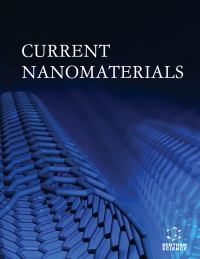- Home
- A-Z Publications
- Current Nanomaterials
- Previous Issues
- Volume 7, Issue 3, 2022
Current Nanomaterials - Volume 7, Issue 3, 2022
Volume 7, Issue 3, 2022
-
-
Nanotechnology Applications in Biomedical Systems
More LessThe current progress in the field of nanotechnology with respect to biomedical and biotechnology is aimed at designing novel materials that have exclusive properties of nanoscale structures. The application of nano-structured materials into biomedical systems has received much attention due to their remarkable resolution in assisting diagnoses and treating medical difficulties. The variety of nanostructured materials produ Read More
-
-
-
A Review on Unknown Repercussions Associated with Metallic Nanoparticles and their Rectification Techniques
More LessAuthors: Saman Aqeel, Aparna Gupta and Lalit SinghBackground: The wide use of metallic nanoparticles (MNPs) has toxic effects on the human body affecting vital organs such as brain, liver and kidney. Therefore it is necessary to develop approaches to eradicate such health issues without compromising plus the potential benefits of the respective metallic nanoparticles including silver, gold, zinc, copper, etc. Objective: This study aimed to assess methods which can mutu Read More
-
-
-
A Review on Properties, Synthesis, Surface Functionalization and Application of Nanodiamonds for Antimicrobial Activity
More LessAuthors: Vandana Tyagi, Amrish Chandra, Neelam Dhankhar and Bhavna TyagiDiamond is a metastable carbon allotrope. Microdiamonds are monocrystalline diamonds with particle sizes of less than 100 nm that have been explored over the last few decades. Nanodiamonds are particularly appealing to provide a variety of possible applications due to their superior mechanical and optical qualities, wide surface area, ease of bioconjugation, and high biocompatibility. In recent years, NDs have gotten Read More
-
-
-
A Review of Nanoparticles Characterization Techniques
More LessAuthors: Pankaj Wadhwa, Supriya Sharma, Sanjeev Sahu, Ajit Sharma and Deepak KumarNanoparticles (NPs) are small materials of sizes 1 to 100 nm and can be divided into different categories according to their properties, shapes, or sizes. They can be classified as metal nanoparticles, carbon-based nanoparticles, semiconductor nanoparticles, ceramics nanoparticles, polymeric nanoparticles, and lipid-based nanoparticles. The basic characteristics used while characterizing the nanoparticles are morphology, size, Read More
-
-
-
Effect of Conditions of the Pulsed Plasma-chemical Synthesis on Physicochemical Properties of the CuxOy/TiO2 Nanocomposite
More LessAuthors: Roman Sazonov, Galina Kholodnaya, Denis Ponomarev and Olga LaptevaAim: This work presents the study results related to the effect of multi-pulse electron beam and additional heating of the reaction mixture on the structural and morphological characteristics of the CuxOy/TiO2 nanocomposite prepared by the pulsed plasma-chemical method. Methods: The CuxOy/TiO2 nanocomposites were characterized by transmission electron microscopy (TEM), energy dispersive X-ray analysis (EDX), an Read More
-
-
-
Optimization of Nanoscience Parameters for Extracting Phenolic Compounds from Ficus religiosa by Three-Phase Partitioning (TPP) Method
More LessAuthors: Nitin M. Rane and Sandeep P. ShewaleBackground: Phenolic compounds are generally found in different parts of various herbs and plants such as leaves, barks, seeds, fruits, etc. These compounds show numerous bioactive properties, including antioxidant characteristics. Phenolic compounds obtained from beneficial herbs and dietary plants include flavonoids and tannins. In recent times, nanoscience has proved to be extensively helpful in extracting bioactive c Read More
-
-
-
Study of Multi-layered Cobalt Silicide Nanostructured Thin Films Prepared by Ion Beam Sputtering
More LessAuthors: Karamjit Kaur and Anil KumarAim: This work focuses on the different existing techniques for synthesis of nanomaterials, the selection of potential process for preparation of Co/Si and Co/Si/Co such that material with optimum characteristics may be obtained. Background: The process of synthesis plays a crucial role in physical properties and associated phenomena acquired by them, and hence is a deciding factor in various potential applications of the Read More
-
Most Read This Month
Article
content/journals/cnm
Journal
10
5
false
en


